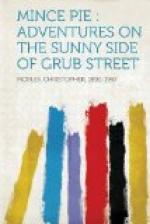Below the windowsill a four-inch
pine shelf is swung, on which rests
a bottle of ink, two or three
pens and a much-rubbed spectacle case.
(The shelf, I am sorry to say, is no longer there.)
The table—between which and the wall is the poet’s rocker covered with a worsted afghan, presented to him one Christmas by a bevy of college girls who admired his work—is so thickly piled with books and magazines, letters and the raffle of a literary desk that there is scarcely an inch of room upon which he may rest his paper as he writes. A volume of Shakespeare lies on top of a heaping full waste basket that was once used to bring peaches to market, and an ancient copy of Worcester’s Dictionary shares places in an adjacent chair with the poet’s old and familiar soft gray hat, a newly darned blue woolen sock and a shoe-blacking brush. There is a paste bottle and brush on the table and a pair of scissors, much used by the poet, who writes, for the most part, on small bits of paper and parts of old envelopes and pastes them together in patchwork fashion.
In spite of a careful examination, I could find nothing in the parlor at all reminiscent of Whitman’s tenancy, except the hole for the stovepipe under the mantel. One of Mrs. Skymer’s small boys told me that “He” died in that room. Evidently small Louis Skymer didn’t in the least know who “He” was, but realized that his home was in some vague way connected with a mysterious person whose memory occasionally attracts inquirers to the house.
Behind the parlor is a dark little bedroom, and then the kitchen. In a corner of the back yard is a curious thing: a large stone or terra cotta bust of a bearded man, very much like Whitman himself, but the face is battered and the nose broken so it would be hard to assert this definitely. One of the boys told me that it was in the yard when they moved in a year or so ago. The house is a little dark, standing between two taller brick neighbors. At the head of the stairs I noticed a window with colored panes, which lets in spots of red, blue and yellow light. I imagine that this patch of vivid color was a keen satisfaction to Walt’s acute senses. Such is the simple cottage that one associates with America’s literary declaration of independence.
The other Whitman shrine in Camden is the tomb in Harleigh Cemetery, reached by the Haddonfield trolley. Doctor Oberholtzer, in his “Literary History of Philadelphia,” calls it “tawdry,” to which I fear I must demur. Built into a quiet hillside in that beautiful cemetery, of enormous slabs of rough-hewn granite with a vast stone door standing symbolically ajar, it seemed to me grotesque, but greatly impressive. It is a weird pagan cromlech, with a huge triangular boulder above the door bearing only the words WALT WHITMAN. Palms and rubber plants grow in pots on the little curved path leading up to the tomb; above it is an uncombed hillside and trees flickering in the air. At this tomb, designed (it is said) by Whitman himself, was held that remarkable funeral ceremony on March 30, 1892, when a circus tent was not large enough to roof the crowd, and peanut venders did business on the outskirts of the gathering. Perhaps it is not amiss to recall what Bob Ingersoll said on that occasion:




